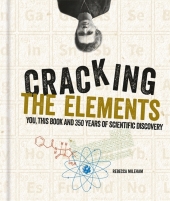 Neuerscheinungen 2018Stand: 2020-02-01 |
Schnellsuche
ISBN/Stichwort/Autor
|
Herderstraße 10
10625 Berlin
Tel.: 030 315 714 16
Fax 030 315 714 14
info@buchspektrum.de |

Rebecca Mileham
Cracking the Elements
You, this book and 350 years of scientific discovery
2018. 320 S. 300 illustrations. 191 x 207 mm
Verlag/Jahr: OCTOPUS PUBLISHING GROUP; CASSELL 2018
ISBN: 1-84403-951-X (184403951X)
Neue ISBN: 978-1-84403-951-7 (9781844039517)
Preis und Lieferzeit: Bitte klicken
Get back to basics with Cracking the Elements, and learn all about the building blocks of life as we know it.
Get back to basics with Cracking the Elements, and learn all about the building blocks of life as we know it.
From the earliest-known elements to those named in 2016, this book takes a comprehensive look at the development of the periodic table - and reveals untold stories, unsung pioneers and plenty of fascinating science along the way.
In twelve illustrated chapters, the book makes sense of the patterns and groups within the periodic table, introducing each of the 118 known elements individually and exploring questions including:
- Why did the history of fizzy water give early chemistry a sparkle?
- How did hydrogen reveal the structure of the atom?
- What was the Bunsen burner´s role in discovering new elements?
- Which of the alkaline earth metals accounts for a kilogramme of your weight?
- Why is Marie Curie such a scientific star?
- How do tungsten and vanadium explain the secret of super-sharp Syrian swords?
- Who discovered the most elements in the periodic table?
- What made nihonium, element 113, such a wonderful new year´s gift for Japan?
- Is glass a liquid or a solid?
- How did nitrogen fulfill the alchemists´ dream?
- Would you have smeared antimony on your face if you´d lived in ancient Egypt?
- Why might naked mole rats have clues for surviving a heart attack?
- How did the Haya people of Tanzania make steel 1500 years ago?
- What makes xenon a great anaesthetic - and why can´t all patients use it?
- Might there be a pattern in yet undiscovered elements beyond number 118?


